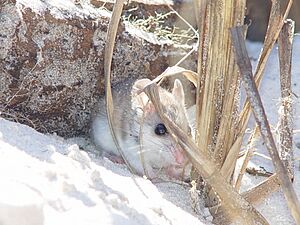Oldfield mouse facts for kids
Quick facts for kids Oldfield mouse |
|
|---|---|
 |
|
| Oldfield mouse at the beach, Alabama | |
| Conservation status | |
| Scientific classification | |
| Genus: |
Peromyscus
|
| Species: |
polionotus
|
| Synonyms | |
|
List
Peromyscus polionotus subsp. polionotus (Wagner, 1843)
Peromyscus polionotus subsp. ammobates Bowen, 1968 Peromyscus polionotus subsp. phasma Bangs, 1898 Peromyscus polionotus subsp. allophrys Bowen, 1968 Peromyscus polionotus subsp. trissyllepsis Bowen, 1968 Peromyscus polionotus subsp. niveiventris (Chapman, 1889) Mus polionotus Wagner, 1843 Peromyscus subgriseus subsp. baliolus Bangs, 1898 Peromyscus phasma Bangs, 1898 Hesperomys niveiventris Chapman, 1889 Peromyscus polionotus subsp. albifrons Osgood, 1909 Peromyscus polionotus subsp. colemani Schwartz, 1954 Peromyscus polionotus subsp. decoloratus A.H. Howell, 1939 Peromyscus polionotus subsp. leucocephalus A.H. Howell, 1920 Peromyscus leucocephalus A.H. Howell, 1920 Peromyscus polionotus subsp. lucubrans Schwartz, 1954 Peromyscus polionotus subsp. peninsularis A.H. Howell, 1939 Peromyscus polionotus subsp. rhoadsi Bangs, 1898 Peromyscus subgriseus subsp. rhoadsi Bangs, 1898 Peromyscus polionotus subsp. subgriseus (Chapman, 1893) Sitomys viveiventris subsp. subgriseus Chapman, 1893 Peromyscus polionotus subsp. griseobracatus Bowen, 1968 Sitomys niveiventris subsp. subgriseus Chapman, 1893 Peromyscus polionotus subsp. sumneri Bowen, 1968 |
|
The oldfield mouse, also called the oldfield deermouse or beach mouse (Peromyscus polionotus), is a small rodent that is active mostly at night. It belongs to the family Cricetidae. These mice mainly eat seeds. They live in burrows they dig in beaches and sandy areas across the Southeastern United States. Birds and other mammals often hunt these mice. In 2016, the oldfield mouse was listed as "least concern" on the IUCN Red List. This means the species as a whole is not currently in danger. However, some types (subspecies) of oldfield mice are extinct, critically endangered, endangered, or near threatened.
Contents
Where They Live
The oldfield mouse can only be found in the southeastern part of the United States. Their home range stretches from Florida all the way up to Tennessee. They prefer to live in sandy places, like beaches and open fields.
What They Look Like
Oldfield mice usually have fawn-colored (light brown) fur on their backs. Their bellies are grey or white. However, mice living on white sandy beaches can be very light or even completely white. This helps them blend in with their surroundings. Mice that live further inland are usually darker and smaller. They also have shorter tails that are dark on top and white underneath. The exact color of their bodies and tails can change a little depending on where they live.
- Length: About 127 millimeters (5 inches)
- Tail: About 47 millimeters (1.8 inches)
- Hind foot: About 16.5 millimeters (0.6 inches)
- Weight: Between 8 and 19 grams (0.28 to 0.67 ounces)
Behavior
Oldfield mice are mostly active at night. This means they are nocturnal.
Diet
P. polionotus mice eat both plants and animals, which makes them omnivores. Their main food is seeds from wild grasses and other plants, which they eat depending on the season. They also enjoy eating blackberries, acorns, and wild peas when they can find them.
Shelter
These mice are skilled at digging burrows in the ground. These burrows serve as their homes and safe places. Sometimes, other animals like spiders or snakes might move into an empty burrow.
Reproduction and Life Cycle
Female oldfield mice can start having babies when they are about 30 days old. Their pregnancy lasts for 23 to 24 days. Each litter usually has 3 to 4 babies. When they are born, the babies weigh about 1.1 to 2.2 grams (0.04 to 0.08 ounces). The young mice are ready to be on their own when they are 20 to 25 days old. Adult mice typically weigh between 8 and 10 grams (0.28 to 0.35 ounces).
Survival
Many animals hunt oldfield mice. Birds, like owls, and various mammals are their main predators. Oldfield mice can also be affected by different types of parasites, especially tiny worms called nematodes. In captivity, one oldfield mouse lived for 5.5 years, which is quite a long time for a small rodent!
Conservation
In 2010, the oldfield mouse was listed as "least concern" on the IUCN Red List. This means the species as a whole is not currently in danger. However, there are sixteen known types (subspecies) of the beach mouse. Out of these, one is now extinct, one is critically endangered, four are endangered, and two are considered near threatened.
The Endangered Species Act of 1973 protects several subspecies of beach mice. These are listed as endangered or threatened:
- Southeastern beach mouse (Peromyscus polionotus niveiventris) – This subspecies is considered Threatened.
- Anastasia Island beach mouse (Peromyscus polionotus phasma) – This subspecies is Endangered.
- Alabama beach mouse (Peromyscus polionotus ammobates) – This subspecies is Endangered.
- Perdido Key beach mouse (Peromyscus polionotus trissyllepsis) – This subspecies is Endangered.
- Choctawhatchee beach mouse (Peromyscus polionotus allophrys) – This subspecies is Endangered.
- St. Andrew beach mouse (Peromyscus polionotus peninsularis) – This subspecies is Endangered.
Sadly, the pallid beach mouse (Peromyscus polionotus decoloratus) is believed to be extinct. The Santa Rosa beach mouse (Peromyscus polionotus leucocephalus) is also in serious trouble. It is listed as critically imperiled by NatureServe.


